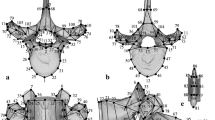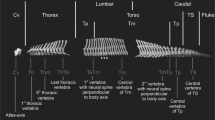Abstract
We investigated allometric relationships between vertebral centrum cranial surface areas and body weight and skeletal lumbar length in extant platyrrhine and cercopithecid species. Platyrrhines have smaller lumbar vertebral centra regarding the cranial surface area relative to their body weight than extant catarrhines. However, the stress to the spine of quadrupeds is not only influenced by the body weight but also its length, which contributes to the amount of bending moment. Our results indicated that platyrrhines and cercopithecids have similar lumbar vertebral centrum surface areas when they are scaled on the product of the body weight and skeletal lumbar length. Platyrrhines generally tend to have relatively short lumbar columns for a given body weight. As a result of this tendency, their vertebral centra appear relatively small if only body weight is taken into account. The centrum surface area is rather constant relative to the product of the body weight and skeletal lumbar length within platyrrhines or cercopithecids, despite the fact that skeletal lumbar length is in itself rather variable relative to body weight. This result indicates that the vertebral centrum articular area, the lumbar column length and the body weight are strongly correlated with each other and that such relationships are similar between platyrrhines and cercopithecids. These relationships were observed using both the zygapophyseal and rib definitions of the lumbar vertebrae. However, they were more clearly observed when the zygapophyseal definition was adopted. It appeared that lumbar vertebrae of Proconsul nyanzae (KNM−MW 13142) had distinctively smaller surface areas relative to its body weight and lumbar length than for platyrrhines and cercopithecids, differing from extant hominoids, which have comparatively larger lumbar vertebrae. In the case of Morotopithecus, the lumbar vertebral surface area seems to be as large as in extant platyrrhines and cercopithecids if it had a reduced number of lumbar vertebrae. It is uncertain whether its lumbar vertebral surface area was as large as in extant hominoids.



Similar content being viewed by others
References
Andrews P (1985) Evolution and environment in the Hominoidea. In: Delson E (ed) Ancestors: the hard evidence. Liss, New York, pp 14–22
Andrews P (1992) Evolution and environment in the Hominoidea. Nature 360:641–646
Badoux DM (1974) An introduction to biomechanical principles in primate locomotion and structure. In: Jenkins FA (ed) Primate locomotion. Academic Press, London, pp 1–43
Erikson GE (1963) Brachiation in New World monkeys and in anthropoid apes. Symp Zool Soc Lond 10:135–164
Fleagle JG (1983) Locomotor adaptations of Oligocene and Miocene hominoids and their phyletic implications. In: Ciochon RL, Corruccini RS (eds) New interpretations of apes and human ancestory. Plenum Press, New York, pp 301–324
Gebo DL, MacLatchy L, Kityo R, Dino A, Kingston J, Pilbeam D (1997) A hominoid genus from the early Miocene of Uganda. Science 276:401–404
Harrison T (1987) The phylogenetic relationships of the early catarrhine primates: a review of the current evidence. J Hum Evol 16:41–80
Harrison T, Sanders WJ (1999) Scaling of lumbar vertebrae in anthropoid primates: its implications for the positional behavior and phylogenetic affinities of Proconsul. Am J Phys Anthropol [Suppl] 28:146
Hurov JR (1987) Terrestrial locomotion and back anatomy in vervets (Cercopithecus aethiops) and patas monkeys (Erythrocebus patas). Am J Primatol 13:297–311
Johanson SE, Shapiro LJ (1998) Positional behavior and vertebral morphology in atelines and cebines. Am J Phys Anthropol 105:333–354
Jolicoeur P (1990) Bivariate allometry: interval estimation of the slopes of ordinary and standardized normal major axes and structural relationship. J Theor Biol 144:275–285
Jungers WL (1984) Scaling of the hominoid locomotor skeleton with special reference to lesser apes. In: Preuschoft H, Chivers DJ, Brockelman WY, Creel N (eds) The lesser apes: evolutionary and behavioural biology. Edinburgh University Press, Edinburgh, pp 146–169
MacLatchy L, Gebo D, Kityo R, Pilbeam D (2000) Postcranial functional morphology of Morotopithecus bishopi, with implications for evolution of modern ape locomotion. J Hum Evol 39:159–183
Majoral M, Berge C, Casions A, Jouffroy F-K (1997) The length of the vertebral column of primates: an allometric study. Folia Primatol 68:57–76
Nakatsukasa M, Hayama S, Preuschoft H (1995) Postcranial skeleton of a macaque trained for bipedal standing and walking and implications for functional adaptation. Folia Primatol 64:1–29
Preuschoft H, Hayama S, Günther MM (1988) Curvature of the lumbar spine as a consequence of mechanical necessities in Japanese macaques trained for bipedalism. Folia Primatol 50:42–58
Rae TC (1997) The early evolution of the hominoid face. In: Begun DR, Ward CV, Rose MD (eds) Function, phylogeny, and fossils: Miocene hominoid evolution and adaptations. Plenum Press, New York, pp 59–77
Rose MD (1975) Functional proportions of primate lumbar vertebral bodies. J Hum Evol 4:21–38
Ruff CB, Walker A, Teaford MF (1989) Body mass, sexual dimorphism and femoral proportions of Proconsul from Rusinga and Mfangano Island, Kenya. J Hum Evol 18:515–536
Sanders WK, Bodenbender BE (1994) Morphometric analysis of lumbar vertebra UMP 67–28: implications for spinal function and phylogeny of the Miocene Moroto hominoid. J Hum Evol 26:203–237
Schultz AH (1938) The relative length of the regions of the spinal column in Old World primates. Am J Phys Anthropol 24:1–22
Schultz AH (1961) Vertebral column and thorax. Primatologia 4:1–66
Shapiro LJ (1991) Functional morphology of the primate spine with special reference to orthograde posture and bipedal locomotion. PhD dissertation. State University of New York
Shapiro LJ (1993) Functional morphology of the vertebral column in primates. In: Gebo DL (ed) Postcranial adaptation in nonhuman primates. Northern Illinois University Press, Dekalb, Ill., pp 121–149
Shapiro LJ, Simons CVM (2002) Functional aspects of strepshirrine lumbar vertebral bodies and spinous processes. J Hum Evol 42:753–783
Slijiper E (1946) Comparative biologic−anatomical investigations on the vertebral column and spinal musculature of mammals. Verh K Ned Akad Wet 42:1–128
Smit TH (2002) The use of a quadruped as an in vivo model for the study of the spine—biomechanical considerations. Eur Spine J 11:137–144
Smith RJ (1994) Regression models for prediction equations. J Hum Evol 26:239–244
Smith RJ, Jungers WL (1997) Body mass in comparative primatology. J Hum Evol 32:523–559
Vilensky JA (1987) Locomotor behavior and control in human and non-human primates: comparisons with cats and dogs. Neurosci Biobehav Rev 11:263–274
Walker AC, Rose MD (1968) Fossil hominoid vertebra from the Miocene of Uganda. Nature 217:980–981
Walker AC, Teaford MF (1989) The hunt for Proconsul. Sci Am 260:76–82
Ward CV (1991) Functional anatomy of the lower back and pelvis of the Miocene hominoid Proconsul nyanzae from Mfangano Island, Kenya. PhD dissertation, Johns Hopkins University
Ward CV (1993) Torso morphology and locomotion in Proconsul nyanzae. Am J Phys Anthropol 92:291–328
Acknowledgements
We thank the curators of Primate Research Institute, Kyoto University, and the Japan Monkey Centre for their permission to access specimens under their care. This research was supported by a Grant-in-Aid for COE Research 2001 and a Grant-in-Aid for Specially Promoted Research (COE) 2002 from The Ministry of Education, Culture, Sports, Science and Technology (MEXT). We appreciate comments by Y. Hamada, M. Natori and another anonymous reviewer on the earlier version of our manuscript.
Author information
Authors and Affiliations
Corresponding author
About this article
Cite this article
Nakatsukasa, M., Hirose, Y. Scaling of lumbar vertebrae in anthropoids and implications for evolution of the hominoid axial skeleton. Primates 44, 127–135 (2003). https://doi.org/10.1007/s10329-002-0010-z
Received:
Accepted:
Published:
Issue Date:
DOI: https://doi.org/10.1007/s10329-002-0010-z




